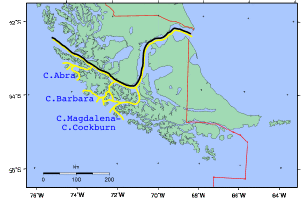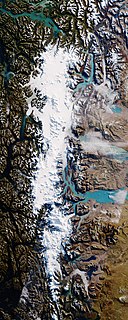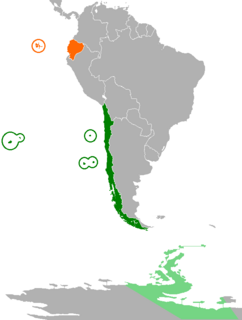See also
| Spanish Wikisource has original text related to this article: |
The Pacts of May (Spanish : Pactos de Mayo) are four protocols signed in Santiago de Chile by Chile and Argentina on 28 May 1902 in order to extend their relations and resolve its territorial disputes. The disputes had led both countries to increase their military budgets and run an arms race in the 1890s.
1. - Acta Preliminar: Argentina renounces the ability to intervene in the Chilean affairs in the Pacific Ocean
2. - Tratado general de Arbitraje: Frames contract to define how to resolve territorial controversies
3. - Convención sobre Limitación de Armamentos Navales: The most famous of the protocols is the arms control treaty. It states that Chile and Argentina will sell off warships they had under construction in Europe and the disarmament of some ships already in service. As a consequence of territorial disputes both countries had begun to increase their military budgets and an arms race ensued in the 1890s. Of longer-lasting importance, the pact resolved the power projection competition by assigning each country a sphere of influence: Chile in the Pacific and Argentina in the Atlantic and Rio de la Plata. According to Rizzo Romano, it is the first arms control pact. [1]
4. - Agreement: to ask the Edward VII of the United Kingdom the demarcation ad hoc of his award of 1902. [2]
During the Beagle Channel Arbitration Argentina brought forward the argument that the Pactos de Mayo implied a demarcation clause between both countries: Chile at the Pacific and Argentina at the Atlantic. Chile denied the argument, saying that the pacts are not a border treaty and therefore no place is named as limit between the Pacific and the Atlantic. Argentina still maintains that Cape Horn is the limit between the two oceans.
| Spanish Wikisource has original text related to this article: |
This article deals with the diplomatic affairs, foreign policy and international relations of Argentina. At the political level, these matters are handled by the Ministry of Foreign Affairs, also known as the Cancillería, which answers to the President. The current Minister of Foreign Affairs, since September 2021, is Chancellor Santiago Cafiero.

The Chilean Navy is the naval warfare service branch of the Chilean Armed Forces. It is under the Ministry of National Defense. Its headquarters are at Edificio Armada de Chile, Valparaiso.

Picton, Lennox and Nueva form a group of three islands at the extreme southern tip of South America, in the Chilean commune of Cabo de Hornos in Antártica Chilena Province, Magallanes and Antártica Chilena Region. Located in the Tierra del Fuego archipelago, they lie east of Navarino Island and are separated from the Argentine part of Isla Grande in the north by the Beagle Channel. They have an area of 170.4 km2 (Lennox), 105.4 km2 (Picton), 120.0 km2 (Nueva).

The Beagle conflict was a border dispute between Chile and Argentina over the possession of Picton, Lennox and Nueva islands and the scope of the maritime jurisdiction associated with those islands that brought the countries to the brink of war in 1978.

The Southern Patagonian Ice Field, located at the Southern Patagonic Andes between Chile and Argentina, is the world's second largest contiguous extrapolar ice field. It is the bigger of two remnant parts of the Patagonian Ice Sheet, which covered all of southern Chile during the last glacial period, locally called the Llanquihue glaciation.

International relations between the Republic of Chile and the Argentine Republic have existed for decades. The border between Argentina and Chile is the world's third-longest international border, which is 5,300 km (3,300 mi) long and runs from north to south along the Andes mountains. Although both countries gained their independence during the South American wars of liberation, during much of the 19th and the 20th century, relations between the countries were chilled as a result of disputes over the border in Patagonia. Despite this, Chile and Argentina have never been engaged in a war with each other. In recent years, relations have improved dramatically in spite of social differences. Despite increased trade between the two countries, Argentina and Chile have followed quite different economic policies. Chile has signed free trade agreements with countries such as China, the US, Canada, South Korea, and the EU, and is an active member of the APEC, while Argentina belongs to the Mercosur regional free trade area. In April 2018, both countries suspended their membership from the UNASUR.
The region of the Beagle Channel, explored by Robert FitzRoy in the 1830s, was one of the last to be colonized by Chile and Argentina. The cold weather, the long distances from other inhabited regions, and the shortage of transport and subsistence, kept it far from the governmental task.

On 22 July 1971 Salvador Allende and Alejandro Lanusse, the Presidents of Chile and Argentina, signed an arbitration agreement. This agreement related to their dispute over the territorial and maritime boundaries between them, and in particular the title to the Picton, Nueva and Lennox islands near the extreme end of the American continent, which was submitted to binding arbitration under the auspices of the United Kingdom government.
Operación Soberanía was a planned Argentine military invasion of Chile due to the Beagle conflict. The invasion was initiated on 22 December 1978 but was halted after a few hours and Argentine forces retreated from the conflict zone without a fight. Whether the Argentine infantry actually crossed the border into Chile has not been established. Argentine sources insist that they crossed the border.
The direct negotiations between Chile and Argentina about the islands and maritime rights in Beagle conflict began after the Queen Elizabeth II of the United Kingdom announced on 2 May 1977 the judgement of the Beagle Channel Arbitration to the governments of both countries. The court ruled that the islands and all adjacent formations belonged to Chile. The direct negotiations finished with the Act of Montevideo on 9 January 1979, where both countries accept the papal mediation after Argentina's call off of the Operation Soberanía. This was the most dangerous phase of the Beagle Conflict and there was a real possibility of open warfare.

The Papal mediation in the Beagle conflict followed the failure of negotiations between Chile and Argentina, when, on 22 December 1978, the Argentinian Junta started Operation Soberanía, to invade Cape Horn and islands awarded to Chile by the Beagle Channel Arbitration. Soon after the event, Pope John Paul II offered to mediate and sent his personal envoy, Cardinal Antonio Samoré, to Buenos Aires. Argentina, in acceptance of the authority of the Pope over the overwhelmingly Catholic Argentine population, called off the military operation and accepted the mediation. On 9 January 1979, Chile and Argentina signed the Act of Montevideo formally requesting mediation by the Vatican and renouncing the use of force.

The Treaty of Peace and Friendship of 1984 between Chile and Argentina was signed into agreement at the Vatican on 29 November 1984.

The Boundary Treaty of 1881 between Argentina and Chile was signed on 23 July 1881 in Buenos Aires by Bernardo de Irigoyen, on the part of Argentina, and Francisco de Borja Echeverría, on the part of Chile, with the aim of establishing a precise and exact border between the two countries based on the uti possidetis juris principle. Despite dividing largely unexplored lands, the treaty laid the groundwork for nearly all of Chile's and Argentina's 5600 km current border.

The Cordillera of the Andes Boundary Case was a British arbitration in 1902 that established the present day boundaries between Argentina and Chile. In northern and central Patagonia, the borders were established between the latitudes of 40° and 52° S as an interpretation of the Boundary treaty of 1881 between Chile and Argentina.

In the late nineteenth and early twentieth centuries, the South American nations of Argentina and Chile engaged in an expensive naval arms race to ensure the other would not gain supremacy in the Southern Cone.

The Treaty of Defensive Alliance was a secret defense pact between Bolivia and Peru. Signed in the Peruvian capital, Lima, on February 6, 1873, the document was composed of eleven central articles, outlining its necessity and stipulations, and one additional article that ordered the treaty to be kept secret until decided otherwise by both contracting parties. The signatory states were represented by the Peruvian Minister of Foreign Affairs, José de la Riva-Agüero y Looz Corswaren, and the Bolivian Envoy Extraordinary and Minister Plenipotentiary in Peru, Juan de la Cruz Benavente.

Chilean–Ecuadorian relations refer to official and bilateral tie between Chile and Ecuador. Two countries have embassies in respective capitals.

Apruebo Dignidad is a left-wing to far-left Chilean electoral coalition officially created on 11 January 2021, by the Equality Party, Broad Front and Chile Digno in preparation for the Constitutional Convention election.

The Charaña Accord, also known as the Hug of Charaña or the Act of Charaña, is the name given to an unrealized treaty that was discussed between the dictators of Bolivia and Chile, Hugo Banzer and Augusto Pinochet respectively. These discussions took place mostly on the Bolivian train station of Charaña on February 8, 1975, and included the brief reestablishment of diplomatic relations between the two nations which had been severed on 1962 because of the Atacama border dispute which was to be solved via a Chilean proposal for the exchange of territories between Bolivia and Chile, with the former receiving a corridor to the Pacific Ocean which would provide it with access to the sea and Chile receiving an equivalent amount of territory from Bolivia along its border with Chile.